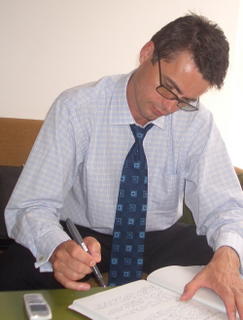Ghel has worked for cities all around the world including Melbourne where most observers would agree his guidance has turned the Melbourne CBD from desolate car dominated streets in the mid 90's to a vibrant and bustling CBD full of people, art and activity today. Melbourne Council gives him the credit for changing city policies in the mid 90's. The City of Sydney's hope is that Ghel can guide our city towards a path of a more quality urban experience and enhanced human scale public spaces in the CBD. This will mean challenges including ultimately taming the dominance of the private motor vehicle in the CBD. But other cities are doing it and the results are not just a more livable city but higher economic productivity and social cohesion.
Today's SMH reports on Jan Ghel:
City with a hole at its heart shown how to get back on its feet
City with a hole at its heart shown how to get back on its feet
A walk on the wild side … Professor Gehl braves the traffic on George Street yesterday.Photo: Peter Rae
Catharine Munro Urban Affairs EditorMay 9, 2007TRAFFIC managers are good at monitoring car movements, but no one is studying how pedestrians use the roads, says the Danish architect Jan Gehl. The oversight could be costly. Professor Gehl believes Sydney - like Melbourne, which he began to study while on sabbatical there in the 1970s - is a "doughnut", because it has nothing in the centre.
"A great proportion of those who use the streets, they have nobody to represent them … they have gradually been treated worse and worse until, in America, they go home and stay home and watch TV and go to the shopping mall and that's the end of life," he said.
The City of Sydney has budgeted almost $300,000 for Professor Gehl's team to observe how pedestrians use the city centre. Perth, Adelaide and Melbourne have also used his services. Melbourne is on his list of nine international success stories. Its achievements have been measured through counting how much life had entered the CBD: the residential apartments, the pavement cafes and the nightlife.
City of Melbourne's director of city design, Rob Adams, said Professor Gehl's two studies, in 1994 and 2004, allowed the city to assess the effect of the changes they made, including the closure of Swanston Street. "Suddenly Swanston Street is the most successful retailing street in Australia," Mr Adams said.
Sydney pedestrians could also "reconquer" the city from the car, Professor Gehl said. "I have the feeling that we should be a little bit bold here and a little bit brave."City of Sydney already plans to give pedestrians room to move on one of its busiest intersections. They have been buying properties opposite Town Hall - including the Woolworths building - in the hope of making room for a park.
A particular bugbear is the pedestrian push button at traffic lights. Professor Gehl argues walkers should not have to "apply" to cross the road. In a study of London traffic, he found most pedestrians crossed against the lights. "Crossing the road is a human right," he argues.
A spokesman for the Roads and Traffic Authority retorted that "not getting hit by a car" was "beneficial to human rights".
Professor Gehl suggests creating a continuous footpath on main streets, so that cars have to drive over the raised area. "Then the cars have the problem," he said.
His recommendations on Sydney will be released in September.


No comments:
Post a Comment